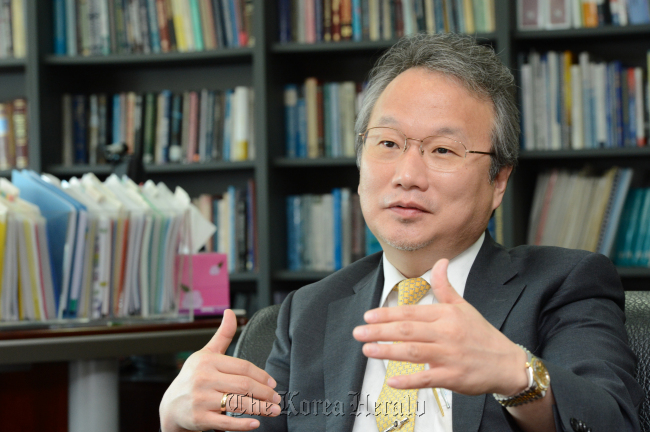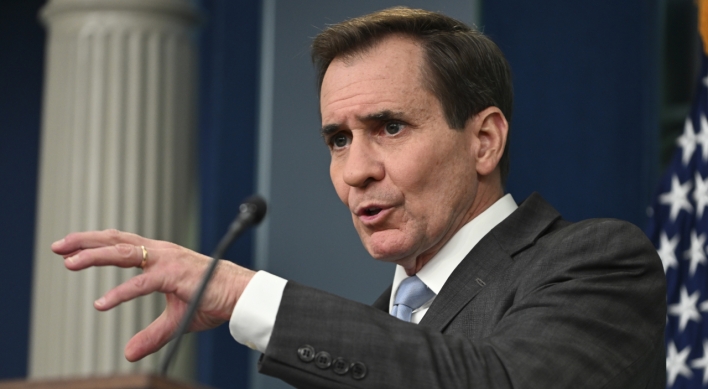 President Yuh aims to build globally competitive school to power Korea’s aerospace industry
President Yuh aims to build globally competitive school to power Korea’s aerospace industryA fleet of training airplanes and a runway greet visitors to Korea Aerospace University.
Founded 60 years ago during the Korean War, the university has long been the main supplier of pilots and aerospace engineers in the nation.
Initially, the school’s primary goal was to educate students to serve in civil and military aviation: Some 600 pilots from the school are currently working at home aabroad.
The country’s first and oldest aerospace educational institution has expanded its areas of research and education to satellite technology, unmanned aerial vehicles, aviation logistics and airport management.
“We also specialize in air and space law. There are not many places providing such courses here in Korea,” Yuh Junku, the president of KAU, said in an interview with The Korea Herald.
A team of researchers from the university developed the country’s first mini-satellite, called Hausat-1, though its launch in 2006 failed after the Russian launch vehicle blew up shortly after its takeoff.
“Now our alumni account for some 15 percent of the R&D workforce in Korean aerospace public and private sectors, and they serve as key researchers in the cutting-edge technology development for the country’s rocket vehicle among other national aerospace programs,” he added.
The university, the president said, is also expanding its research into various aerospace fields, including advanced unmanned vehicles and satellite technologies.
As a result, KAU recorded a six-year average post-graduation emploment rate of 72.5 percent from 2006-2011. In 2011, in particular, it ranked third among universities across the country with more than 1,000 graduates with a rate of 74 percent.
Yuh was inaugurated as president of KAU in November 2006. Previously he taught at the University of Hawaii for 18 years and then joined the National Science Foundation of the United States, where he served as director of Robotics programs and head of the Tokyo Regional Office.
Yuh, 54, is one of the world’s leading authorities in robotics. In particular, he carried out various projects with renowned researchers for developing underwater robots.
“The basic principle is quite similar in the air or underwater. Both deal with fluid mechanics. Also, I came here not to conduct research, but to manage the school,” he said.
With science and technology increasingly globalized, the president with long experience abroad said he wanted to play a critical role in bridging the research and education communities of Korea.
Since his inauguration, Yuh has been working hard to expand and upgrade facilities to enhance KAU’s competitiveness and attract more talented students.
“Our main campus site is in a green belt area and surrounded by military premises, so it’s quite tough for us to construct buildings,” he admitted.

But with his relentless efforts, the university’s first student residence hall was completed in 2009, and a new administrative building, hangar and traffic control tower were also completed under his command.
The university took another step in strengthening its position as the leading aerospace institution this spring with the introduction of a new air traffic control lab.
With 550 million won in funding ($487,000), the lab is equipped with a cutting-edge air traffic simulator that allows students to train under various scenarios, including runways at Incheon International Airport and Gimhae International Airport in Busan.
“But we still need to build more buildings and facilities for students, and in order to do that the government’s support is crucial,” he said.
Yuh noted that the global economic downturn has hit the global aviation sector hard. Cargo traffic has declined and heated competition and other issues are adding to the industry’s troubles.
Nonetheless, the need for air transportation is continuing to grow, especially in East Asia, and therefore so is the demand for a skilled workforce, he said.
The country’s leading pilot training institution produces 60 new pilots every year, and currently some 250 students are being trained at its main campus in Goyang, Gyeonggi Province, and its training centers in Jeju Island and Uljin, North Gyeongsang Province.
But the number is still too small to meet the soaring demand for experienced pilots, Yuh admitted.
“We need more support from the government to foster highly skilled pilots,” he said.
Yuh also expressed concerns about the declining number of students in Korea.
The number of high-school graduates is expected to drop by nearly 40 percent from 670,000 in 2012 to 410,000 in 2024. And by 2018, the university entrance quota will exceed the number of high-school graduates, according to the Ministry of Education, Science and Technology.
“The problem is there will be more competition among universities due to the shrinking number of students. But the more serious problem is that there will be a significant reduction in the number of highly educated young Koreans,” he said.
The solution, he said, is to draw more investment from businesses to universities. Not only large conglomerates, but also small and medium-sized firms in Korea need to invest to secure talented students, he claimed.
“It’s a win-win strategy for both the schools, the business and the country,” he said.
KAU has been closely linked for decades to Korean Air, now one of the world’s top 10 airlines and the world’s top air cargo service. It also has international collaborative research projects with leading global firms such as GE and Airbus.
With a partnership with Korean Air, KAU runs an airline pilot program at the Flight Safety Academy in Florida and provides internship programs at Ameriflight, one of the largest U.S. cargo carriers based in California.
KAU is also currently in partnership for student exchange programs with 62 institutions in 21 countries across the globe, including the University of North Dakota in the U.S. and Hong Kong Polytechnic University, Yuh noted.
“KAU is no longer a regional university. We are a small but strong university producing many leading experts in aerospace field,” he said.
Yuh noted that he believes Korea has great potential for the future in the aerospace industry.
“The global space market is expected to reach $580 billion, but Korea’s share is less than 1 percent with some $4.8 billion,” he said.
“We are making the greatest effort to make this university one of the world’s top educational institutions of aviation and aerospace technology since we know that it promises a bright future for the country,” he added.
Yuh Junku
● Yuh took office as president of Korea Aerospace University in November 2006. He worked as a professor at the University of Hawaii for 18 years and then joined the National Science Foundation, where he served as director of Robotics programs and Head of the Tokyo Regional Office.
● Yuh graduated from Seoul National University with a bachelor’s degree in engineering, and earned his master’s and doctoral degrees in mechanical engineering from Oregon State University.
● Yuh is an elected fellow of the Institute of Electrical and Electronics Engineers and received several prestigious awards, including an NSF Presidential Young Investigator Award from the U.S. president.
By Oh Kyu-wook (596story@heraldcorp.com)
-
Articles by Korea Herald





![[Music in drama] Rekindle a love that slipped through your fingers](http://res.heraldm.com/phpwas/restmb_idxmake.php?idx=644&simg=/content/image/2024/05/01/20240501050484_0.jpg&u=20240501151646)



![[New faces of Assembly] Architect behind ‘audacious initiative’ believes in denuclearized North Korea](http://res.heraldm.com/phpwas/restmb_idxmake.php?idx=644&simg=/content/image/2024/05/01/20240501050627_0.jpg&u=20240502093000)









![[Today’s K-pop] Stray Kids go gold in US with ‘Maniac’](http://res.heraldm.com/phpwas/restmb_idxmake.php?idx=642&simg=/content/image/2024/05/02/20240502050771_0.jpg&u=)